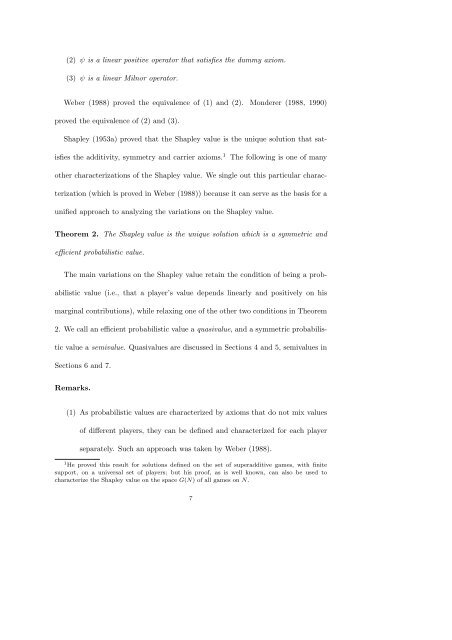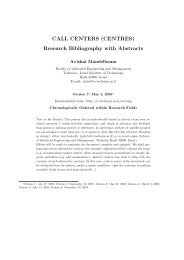Variations on the Shapley value
Variations on the Shapley value
Variations on the Shapley value
You also want an ePaper? Increase the reach of your titles
YUMPU automatically turns print PDFs into web optimized ePapers that Google loves.
(2) ψ is a linear positive operator that satisfies <strong>the</strong> dummy axiom.<br />
(3) ψ is a linear Milnor operator.<br />
Weber (1988) proved <strong>the</strong> equivalence of (1) and (2). M<strong>on</strong>derer (1988, 1990)<br />
proved <strong>the</strong> equivalence of (2) and (3).<br />
<strong>Shapley</strong> (1953a) proved that <strong>the</strong> <strong>Shapley</strong> <strong>value</strong> is <strong>the</strong> unique soluti<strong>on</strong> that sat-<br />
isfies <strong>the</strong> additivity, symmetry and carrier axioms. 1 The following is <strong>on</strong>e of many<br />
o<strong>the</strong>r characterizati<strong>on</strong>s of <strong>the</strong> <strong>Shapley</strong> <strong>value</strong>. We single out this particular charac-<br />
terizati<strong>on</strong> (which is proved in Weber (1988)) because it can serve as <strong>the</strong> basis for a<br />
unified approach to analyzing <strong>the</strong> variati<strong>on</strong>s <strong>on</strong> <strong>the</strong> <strong>Shapley</strong> <strong>value</strong>.<br />
Theorem 2. The <strong>Shapley</strong> <strong>value</strong> is <strong>the</strong> unique soluti<strong>on</strong> which is a symmetric and<br />
efficient probabilistic <strong>value</strong>.<br />
The main variati<strong>on</strong>s <strong>on</strong> <strong>the</strong> <strong>Shapley</strong> <strong>value</strong> retain <strong>the</strong> c<strong>on</strong>diti<strong>on</strong> of being a prob-<br />
abilistic <strong>value</strong> (i.e., that a player’s <strong>value</strong> depends linearly and positively <strong>on</strong> his<br />
marginal c<strong>on</strong>tributi<strong>on</strong>s), while relaxing <strong>on</strong>e of <strong>the</strong> o<strong>the</strong>r two c<strong>on</strong>diti<strong>on</strong>s in Theorem<br />
2. We call an efficient probabilistic <strong>value</strong> a quasi<strong>value</strong>, and a symmetric probabilis-<br />
tic <strong>value</strong> a semi<strong>value</strong>. Quasi<strong>value</strong>s are discussed in Secti<strong>on</strong>s 4 and 5, semi<strong>value</strong>s in<br />
Secti<strong>on</strong>s 6 and 7.<br />
Remarks.<br />
(1) As probabilistic <strong>value</strong>s are characterized by axioms that do not mix <strong>value</strong>s<br />
of different players, <strong>the</strong>y can be defined and characterized for each player<br />
separately. Such an approach was taken by Weber (1988).<br />
1 He proved this result for soluti<strong>on</strong>s defined <strong>on</strong> <strong>the</strong> set of superadditive games, with finite<br />
support, <strong>on</strong> a universal set of players; but his proof, as is well known, can also be used to<br />
characterize <strong>the</strong> <strong>Shapley</strong> <strong>value</strong> <strong>on</strong> <strong>the</strong> space G(N) of all games <strong>on</strong> N.<br />
7
















